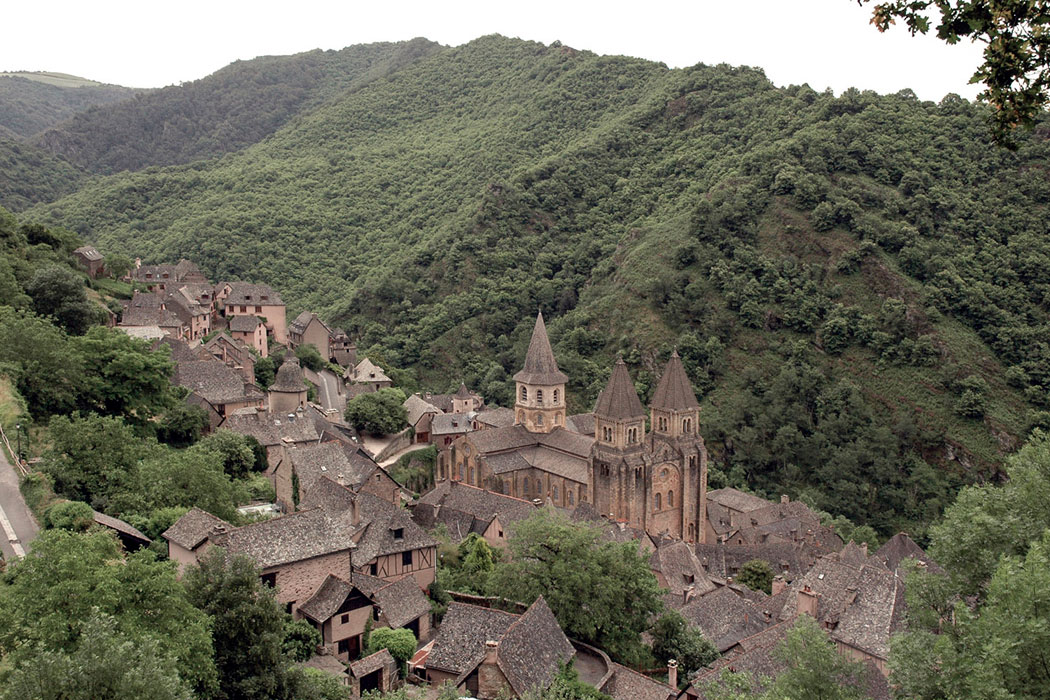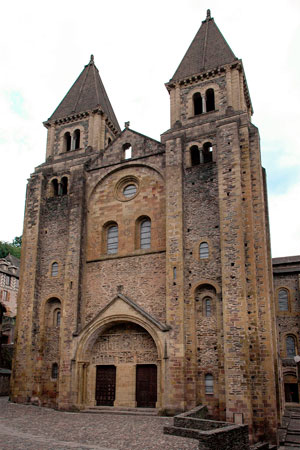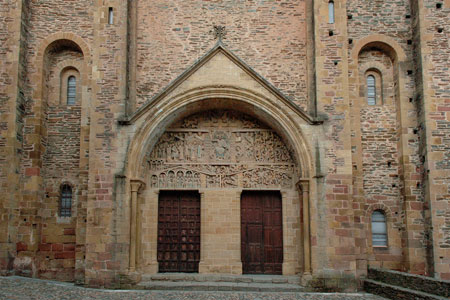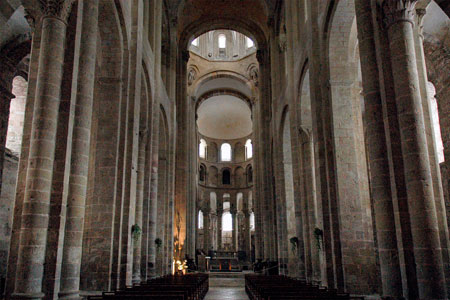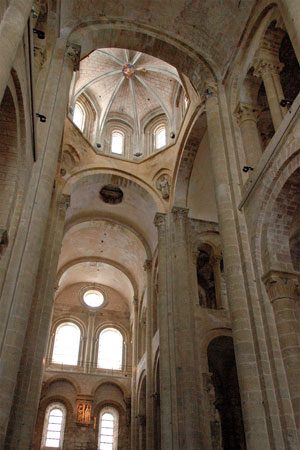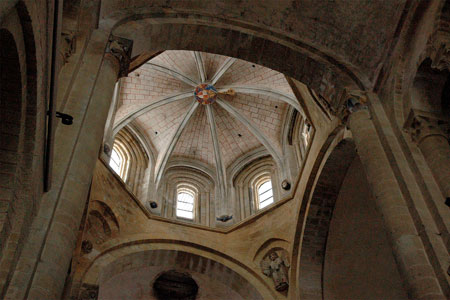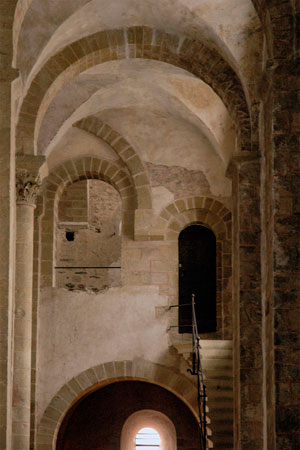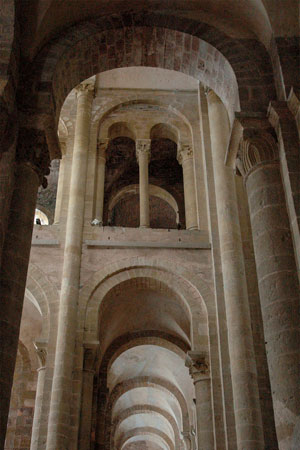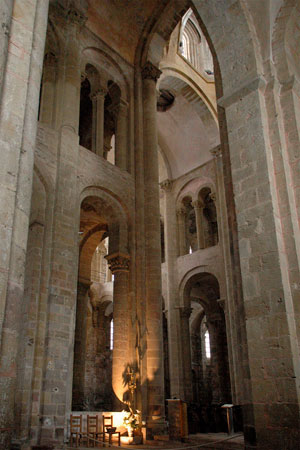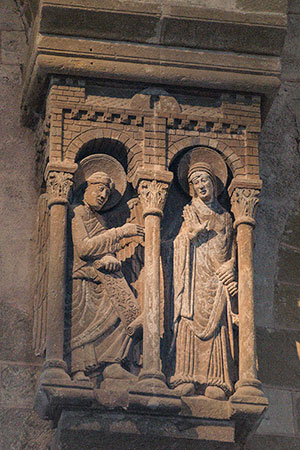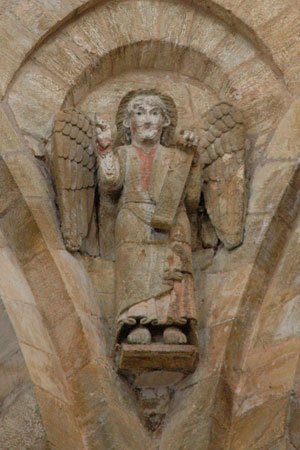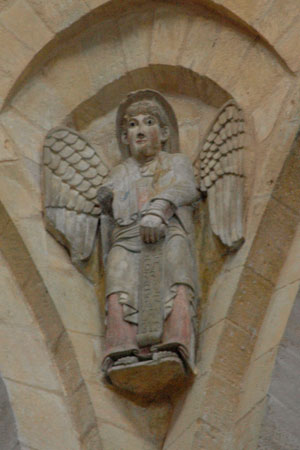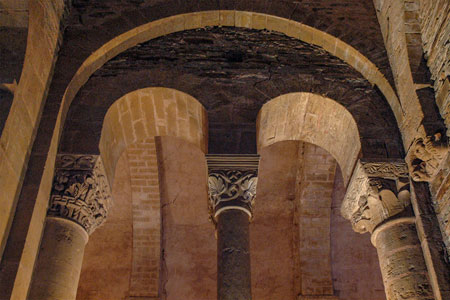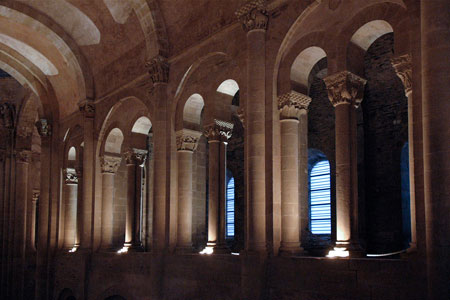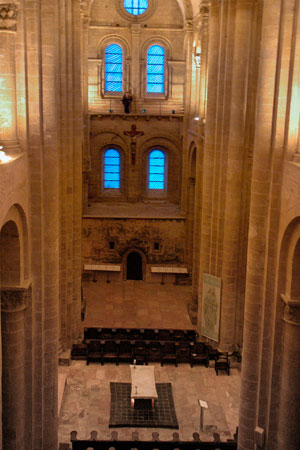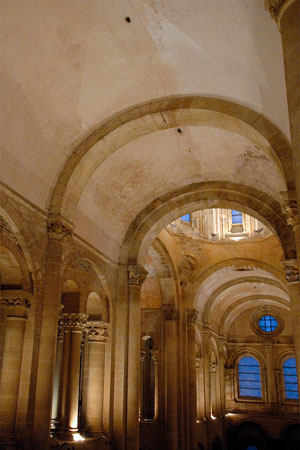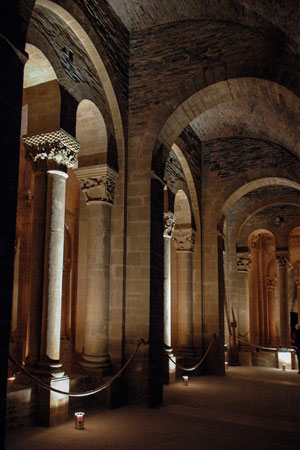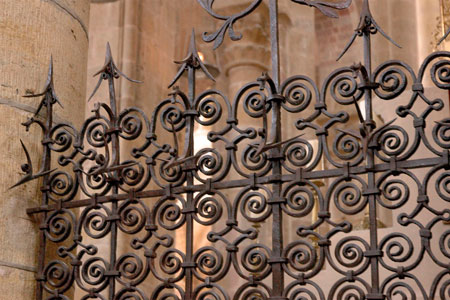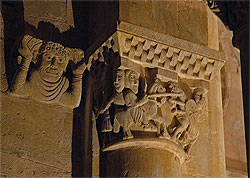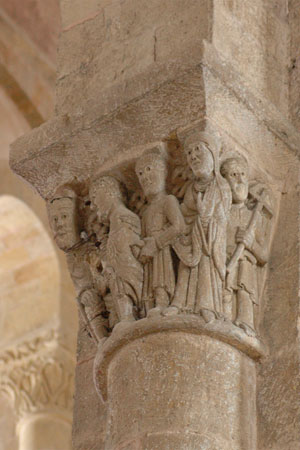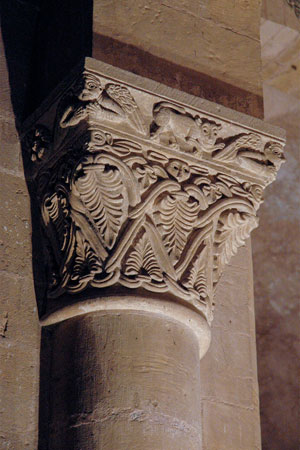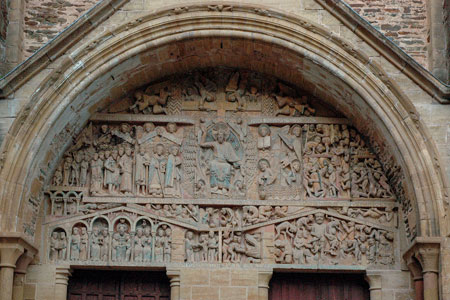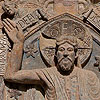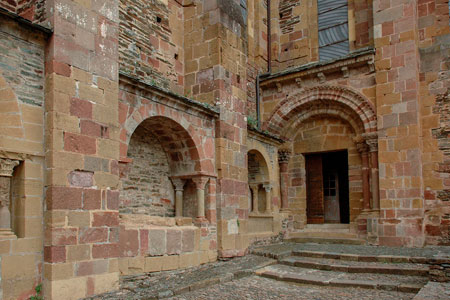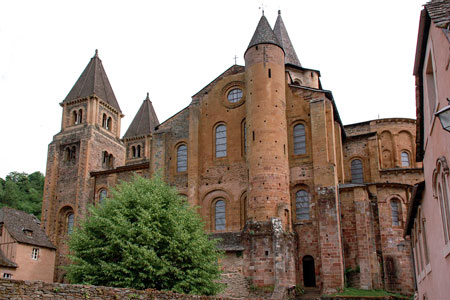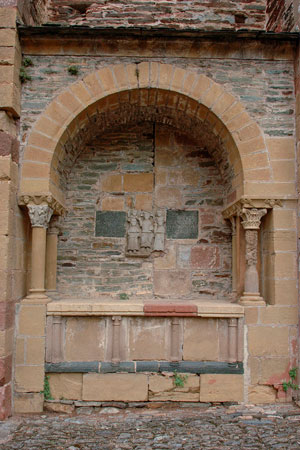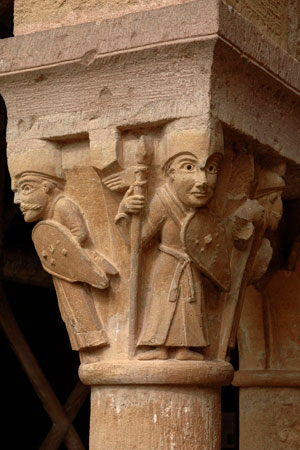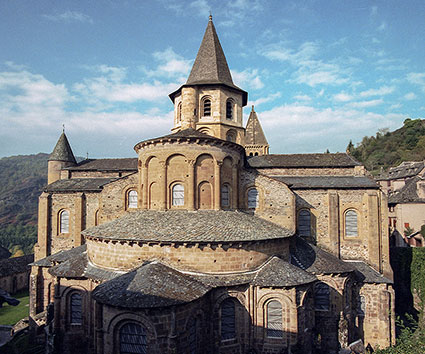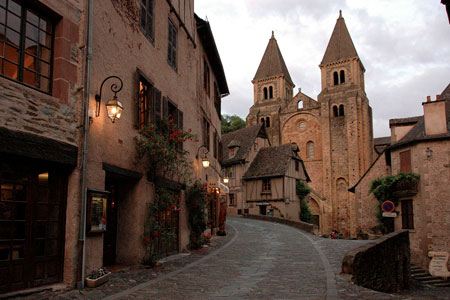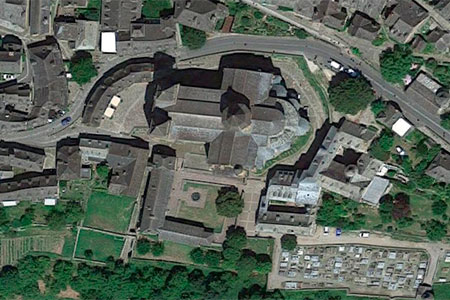Abbey of Sainte-Foy de Conques
Abbaye Sainte-Foy de Conques / Saint-Sauveur et Sainte-Foy / S Fidei / Conchas
(Conques-en-Rouergue, Aveyron)
The abbey is dedicated to Saint Faith (Foy), a young martyr from Agen (Lot-et-Garonne) who lived at the beginning of the 4th century. The body of the saint, highly venerated in that town, was taken by the monks of Conques around 865, after having tried to obtain other relics without success. In fact, there is evidence of the veneration of the relics of Saint Faith in this place since 884.
This place may already have been inhabited in the Merovingian period, but the first known record of the hermit Datus (Deodatus) dates from the end of the 8th century. Datus was accompanied by Medraldus. The former retired to a solitary place, leaving Medraldus in charge of the incipient monastery, which had adopted the Benedictine rule. That first monastery was dedicated to Saint-Sauveur. In 819, Louis the Pious endowed the house and placed it under his protection. With the arrival of the relics of Saint Faith, the place acquired renown and the devotion of the faithful, leading to a period of religious and economic vitality. A valuable collection of goldsmith's work was soon assembled, of which a considerable sample is still preserved. A series of miracles took place during this period through the intervention of the saint, making Conques the center of a cluster of churches and possessions, both in the same region and in distant places. For example, in 1098, the bishop of Barcelona, Folc de Cardona, granted her the parish of Tagamanent (Vallès Oriental).
At the end of the 9th century, the monastery's title was changed, and it was consecrated to Sainte-Foy. In 838, the abbot of Conques, with the support of Pepin II of Aquitaine, had founded the abbey of Saint-Sauveur de Figeac (Lot), which eventually led to a long conflict between the two houses that could not be resolved until 1097, when they finally separated. Between the 11th and 12th centuries, and especially under the abbacy of Bégon III (1087-1107), the abbey lived its golden age with the construction of the church, the cloister and other monastic buildings. However, due to, among other things, the Black Death (1348) and the Hundred Years' War, the monastery suffered a severe period of decline, which was accompanied by a relaxation of customs within the monastery. In 1424 the community was reduced to only twenty-nine monks, whereas in earlier times it had numbered more than a hundred. In 1537 Pope Paul III intervened and dissolved the Benedictine community and secularised the house, establishing a canonical collegiate church.
In the 16th century, it suffered the effects of the Wars of Religion. In anticipation of irreparable losses, the canons hid the treasure and the relics of Saint Faith, saving them from destruction. The collegiate church went through periods of looting in the same century, and in 1628 it was affected by a new episode of plague. Later, during the Revolution, the canons were forced to leave the abbey. Around 1830, part of the cloister was sold. The site was badly damaged, and there were no financial means to restore it. The writer Prosper Mérimée, then Inspector of Monuments Historiques, managed to prevent the ruin of the monument by classifying it in 1838. The treasure, which had been hidden and practically forgotten during the Revolutionary period, was also recovered. In 1873, Conques was occupied by a Premonstratensian community from Saint-Michel de Frigolet (Bouches-du-Rhône) and restored. It now belongs to the abbey of Mondaye (Calvados).
The present church began to be built in the abbacy of Odolric (1031-1065) on a primitive building, a Carolingian building and a later one, dating from the second half of the 10th century. This work was continued by his successors Étienne II (1065-1087) and especially Begon III (1087-1108) and was completed by Abbot Boniface (1107-1125). It is a remarkable building with three naves and a transept. The aisles are connected behind the presbytery to form an ambulatory with three apsidal chapels. The large transept also has three naves, like the central body of the building. The central nave is covered by a semicircular vault and the side naves, which are lower, have a wide tribune with large windows that open onto the central nave. The same structure is repeated in the transept.
The original Romanesque roof lantern collapsed at an undetermined time, probably due to structural deficiencies, and was rebuilt between 1460 and 1490 using Gothic techniques. Later, following a fire, the interior pillars had to be reinforced. Inside, sculptural elements, capitals, and an interesting group depicting the Annunciation can be seen. The presbytery has a grille from the period. The massive façade is flanked by two bell towers, with little visible buttressing.
The tympanum
The main door is decorated with a magnificent tympanum. It is one of the major works of Romanesque sculpture, of large dimensions (6.70 x 3.60 m). An anonymous work (Master of the Tympanum) executed under the abbacy of Boniface (1107-1125), it is dedicated to the Last Judgment. The piece is divided horizontally into three sections: in the center, Christ the Judge; to his right, a group including the Virgin Mary, Saint Peter, an abbot, and other figures; to the left, a group of the condemned. The lower register centers on scenes of the Weighing of Souls, with entrances to Paradise and Hell represented on either side.
The cloister
One of the wings of the cloister is preserved with a gallery of double columns with capitals, the result of a reconstruction made with scattered elements. Attached to the church, in the cloister area, is an arcosolium with the tomb of Abbot Bégon III, also from the reconstruction period. It should be noted that the cloister was badly damaged by a fire in 1366 and was not recovered.
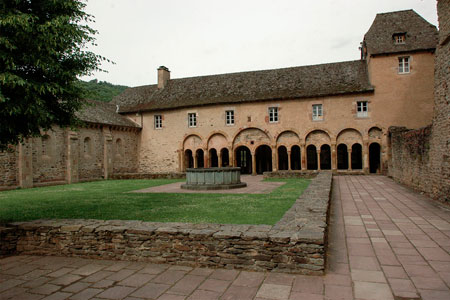
Site of the ancient cloister
The Conques Abbey still keeps the precious treasure of medieval goldsmithing, among its pieces it is worth highlighting:
- Majesty of Saint Faith
Created to preserve the skull of the saint. There was an earlier image, but in the year 985, as a result of the devotion awakened by one of her miracles, it was profoundly remade. The piece that can now be seen already had this appearance in the 11th century. It is a wooden image of the saint sitting on a throne. It is entirely gilded and inlaid with various precious stones. - Reliquary of Pepin, or of The Circumcision
Gold, precious stones and enamels. From the 8th century with many modifications, until the 16th century. Traditionally, it is accepted that it is a donation from King Pepin (the Short or of Aquitaine), it is also said that it was used to keep the relic of the Holy Prepuce. - Pentagonal reliquary
With elements from the 7th to 13th centuries. It holds relics of various saints. - Hexagonal reliquary
With elements from the 7th to 12th centuries. It also holds the relics of various saints. - Bégon lantern
Second half of the 12th century. Gilt silver. Holds relics of prophets.
- Charlemagne reliquary “A”
From the time of Bégon III, with earlier elements and later modifications. Gold, silver, precious stones and enamels. - Pope Paschal II reliquary
From 1100. Gilt silver. With the representation of Christ crucified between the Virgin Mary and Saint John. - Portable altar of Saint Faith
- Portable altar of Bégon
- Processional cross, Gothic
- Reliquary triptych
- Reliquary arm of Saint George
- AUBERT, Marcel (1938). Conques-en-Rouergue. Congrès Archéologique de France. 100e session. Figeac, Cahors et Rodez. París: Picard
- BEAUNIER, Dom (1911). Abbayes et prieurés de l'ancienne France. Vol. 4: Alby, Narbonne et Toulouse. Abbaye de Ligugé
- BOUILLET, Auguste (1892). L'église et le trésor de Conques (Aveyron) notice descriptive. Mâcon: Protat
- BOUILLET, Auguste; i altres (1900). Sainte Foy, Vierge et Martyre. Rodez: Carrere
- BOUSQUET, F. (1956). Conques. Dictionnaire d'histoire et de géographie ecclésiastiques. Vol. 13. París: Letouzey et Ané
- BOUVET-LANSELLE, Violaine; dir. (2001). Le trésor de Conques. París: Monum, Èditions du patrimoine
- COTTINEAU, Laurent-Henri (1936). Répertoire topo-bibliographique des abbayes et prieurés. Vol. 1. Mâcon: Protat
- DELMAS, Claire; i altres (1989). Conques. Millau: Beffroi
- DESJARDINS, Gustave (1872). Essai sur le cartulaire de l'abbaye de Sainte-Foi de Conques de Rouergue (Ixe-XII siècles). París
- DESJARDINS, Gustave (1879). Cartulaire de l'abbaye de Conques en Rouergue. París: Picard
- DEVIC, Claude; i altres (1872). Histoire générale de Languedoc. Vol. 4. Tolosa de Ll.: Privat
- DEYRES Marcel (1965). La construction de l'abbatiale Sainte-Foy de Conques. Bulletin Monumental, vol. 123
- FAU, Jean-Claude (1956). Les chapiteaux de l'église et du cloître de Conques. Mémoires de la Société archéologique du Midi de la France. Vol. 24. Tolosa de Ll.: Privat
- GAILLARD, Georges (1974). Rouergue roman. Zodiaque: La Nuit des temps
- HARMEL, Jean-Régis (sd). Les chapiteaux de Conques. Conques
- HARMEL, Jean-Régis (sd). Santa Fe. Nacida en Agén, venerada en Conques. Intediprint
- JEANNIN, Emmanuelle (2008). Conques. Moisenay: Gaud
- LOT, Ferdinand (1904). Sur la date de la translation des reliques de Sainte Foi d'Agen à Conques. Annales du Midi, núm. 64
- SAINT-MAUR, Congregació de (1715). Gallia Christiana in provincias ecclesiasticas distributa. Vol. 1. París: Coignard
- SALTET, Louis (1924). Perse et Conques. Rapports entre deux portails voisins du XIIe siècle. Bulletin de la Société archéologique du Midi de la France. Tolosa de Ll.: Privat
- SERVIÈRES, Louis (1874). Histoire de l'église du Rouergue. Rodés: Carrère
- SOLMS, Élisabeth; tr. (1965). Sainte-Foy de Conques. Zodiaque: Les Points Cardinaux
